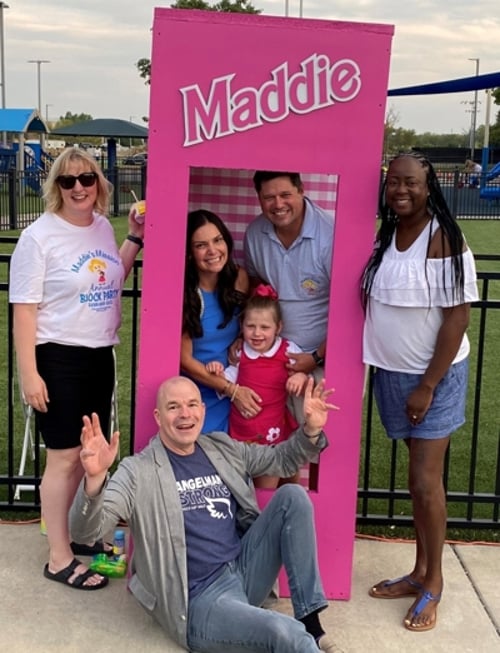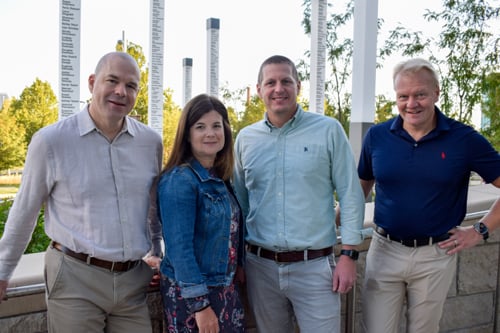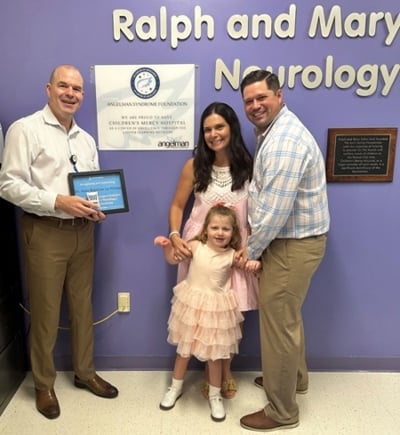Jean-Baptiste Le Pichon, MD, PhD, FAAP
Madison Lauren Sargent Endowed Professorship in Neurology/Angelman Syndrome; Interim Division Director, Division of Neurology; Director, Neuroscience Research; Professor of Pediatrics, University of Missouri-Kansas City School of Medicine; Clinical Assistant Professor of Pediatrics, University of Kansas School of Medicine
Full BiographyEmily G. Farrow, PhD, CGC, FACMG
Director, Laboratory Operations, Genomic Medicine Center; Associate Professor of Pediatrics, University of Missouri-Kansas City School of Medicine; Clinical Assistant Professor of Pathology, University of Kansas School of Medicine
Full BiographyScott T. Younger, PhD
Director, Disease Gene Engineering; Associate Professor of Pediatrics, University of Missouri-Kansas City School of Medicine; Research Assistant Professor of Pediatrics, University of Kansas School of Medicine
Full BiographyTomi Pastinen, MD, PhD
Vice President, Associate Chief Medical Officer for Clinical and Research Integration, CMRI; Division Director, Center for Pediatric Genomic Medicine; Dee Lyons/Missouri Endowed Chair in Pediatric Genomic Medicine, Pediatrics/Genomic Medicine Center (GMC); Professor of Pediatrics, University of Missouri-Kansas City School of Medicine; Research Professor of Cancer Biology, University of Kansas School of Medicine
Full Biography
Jean-Baptiste Le Pichon, MD, PhD, FAAP, Neurology, was first approached about creating and running the first regional Angelman Syndrome Clinic at Children’s Mercy-Kansas City in February 2022. By June, he agreed to the idea and just nine months later, on December 15, the clinic officially launched.
The idea was accelerated through the generosity and perseverance of Laura and Patrick Sargent, whose daughter Maddie was diagnosed with Angelman syndrome at Children’s Mercy in January 2020, along with other committed donors.
What is Angelman syndrome?
Named after the physician who discovered the disorder, Angelman syndrome (AS) is a rare genetic disorder caused when one gene on the 15th chromosome, called UBE3A, is missing (deletion) or has a mistake causing errors in its transcription (the process of going from a gene to a protein). Experts still don’t understand everything about the UBE3A gene, but they do know that it is important to brain development, speech, movement, and learning. About one in every 15,000 children is born with AS, equating to around seven new diagnoses in Missouri and Kansas each year — and a half a million people living with Angelman syndrome around the globe.
Caretakers and physicians usually start to notice symptoms of AS between birth and 12 months of age. They include:
- Low muscle tone
- Positive, excitable temperament
- Developmental delays
- Seizures
- Sleep issues
- Speech issues
- Gastrointestinal issues
- Behavioral problems
Often misdiagnosed as autism or cerebral palsy due to overlapping symptoms; genetic testing can tell if a child’s UBE3A gene is affected.
“When diagnosed, we were told a lot of things about Maddie — she may not walk, she won’t be potty trained, she won’t be independent, she won’t communicate,” said Laura Sargent.
After the diagnosis, the Sargents began meeting other Angelman families in the area and found many didn’t have the resources to travel to specialists or were struggling with the insurance process. Through their connections with other Angelman families, they met with Diane and Terry Gallagher, whose daughter, Elizabeth, also had AS, to discuss their shared passion for supporting care and research.
“We did not find out that Elizabeth had a genetic disorder until she was 10 years old. Everybody thought there was something wrong, but they never knew what it was. So, we didn't find out until much further along in her life that it was Angelman’s,” said

Terrence Gallagher. “My pride is in that I'm able to give back to an organization, Children’s Mercy, that allowed us to have our daughter live as long as she did and bring us the happiness and joy that she did before she passed away in 2019.”
Gifts from the Sargents, their nonprofit Maddie’s Mission, the Gallaghers, and the Angelman Syndrome Foundation support the new Angelman Syndrome Clinic and Angelman syndrome research efforts.
Based on families’ needs, the Angelman Syndrome Clinic at Children’s Mercy is designed to be a medical home for area patients as well as a hub for innovative new research on the disease.
The Research Connected to the Clinic
Dr. Le Pichon teamed up with Emily Farrow, PhD, CGC, Assistant

Clinical Director with Clinical Genetics, and Director, Laboratory Operations, Genomic Medicine Center, Scott Younger, PhD, Director, Disease Gene Engineering, Genomic Medicine Center, and Tomi Pastinen, MD, PhD, Director, Genomic Medicine Center, principal investigator of Genomic Answers for Kids, to pursue AS research.
“There are things we already know about children with Angelman syndrome, such as that those with the deletions typically are more severely affected than the kids who have just a point mutation or a methylation defect,” said Dr. Le Pichon. “But there is also so much we don’t know. That region of chromosome 15 has a number of genes that are involved, so one of the things we want to look into is if it makes a difference whether all of the genes in that region are involved or just a few of the genes. Also, not every child with Angelman syndrome has epilepsy and we want to investigate why that is.”
Using long-read, 5-base technology (HiFi-GS), the team can detect all the known mechanisms leading to Angelman syndrome in a single test.
“We pioneered research use of the HiFi-GS in the Genomic Answers for Kids program and have already uncovered potentially previously unidentified cases of Angelman syndrome,” explained Dr. Pastinen. “By expanding HiFi genomic sequencing to a larger clinical population – the first hospital in the U.S. to do so – we will uncover ‘hidden cases’ of AS. Characterizing these patients in comparison to classical (physician suspected) AS will expand the phenotypic spectrum of AS and allow new patients to be eligible for ongoing therapeutic trials in AS.”
Dr. Farrow is positioned to focus on Children’s Mercy’s translational research and and how the organization can leverage and build on Genomic Answers for Kids, develop new technologies, and move them to use with patients.
Dr. Farrow received a grant from the Angelman Syndrome Foundation to develop a new novel long-read based comprehensive panel test for all variations of genetic diagnosis for Angelman syndrome.
“The goal of the panel is to have a comprehensive, efficient, and cost-effective way to test young children for Angelman syndrome and top differentials to ensure we are providing them not only a molecular diagnosis, but the most appropriate treatment,” said Dr. Farrow. “As precision therapeutics are being developed, it is critical we get the correct molecular diagnosis as quickly as possible."
One benefit for this single test is the ease and earlier option for diagnosis because it is well established that the earlier you start a child on gene therapy, the better they do.
The first year of the funded project is focused on the development of the panel. In year two, once developed and validated, Dr. Farrow and her team can deploy the panel to patients to evaluate the test performance in a rare disease cohort. The team will evaluate if the new panel test improves time and cost to diagnosis leading to better outcomes.
“One benefit for this single test is the ease and earlier option for diagnosis because it is well established that the earlier you start a child on gene therapy, the better they do. Having an early diagnosis is important,” said Dr. Le Pichon.

Looking to the future
Currently there is no cure for AS, but researchers are working on promising therapies. As the Angelman Syndrome Clinic at Children’s Mercy looks to the future, Dr. Le Pichon said parents have voiced their interest in being involved in clinical trials for antisense oligonucleotide (ASO) therapy, which they hope to fulfill.
Drs. Le Pichon, Younger, and Pastinen are also building the infrastructure to generate patient-derived cellular models and evaluate potential therapeutic approaches using those models.
As for Maddie, now five years old, her parents say she is doing all the things that they were told she probably wouldn’t be able to do.
“In a video of us presenting the endowment to Dr. Le Pichon, she walked in and gave him a hug. She’s potty training. We are just so impressed with everything that she can do because people believe in her and because we have wonderful support,” said Laura Sargent.
